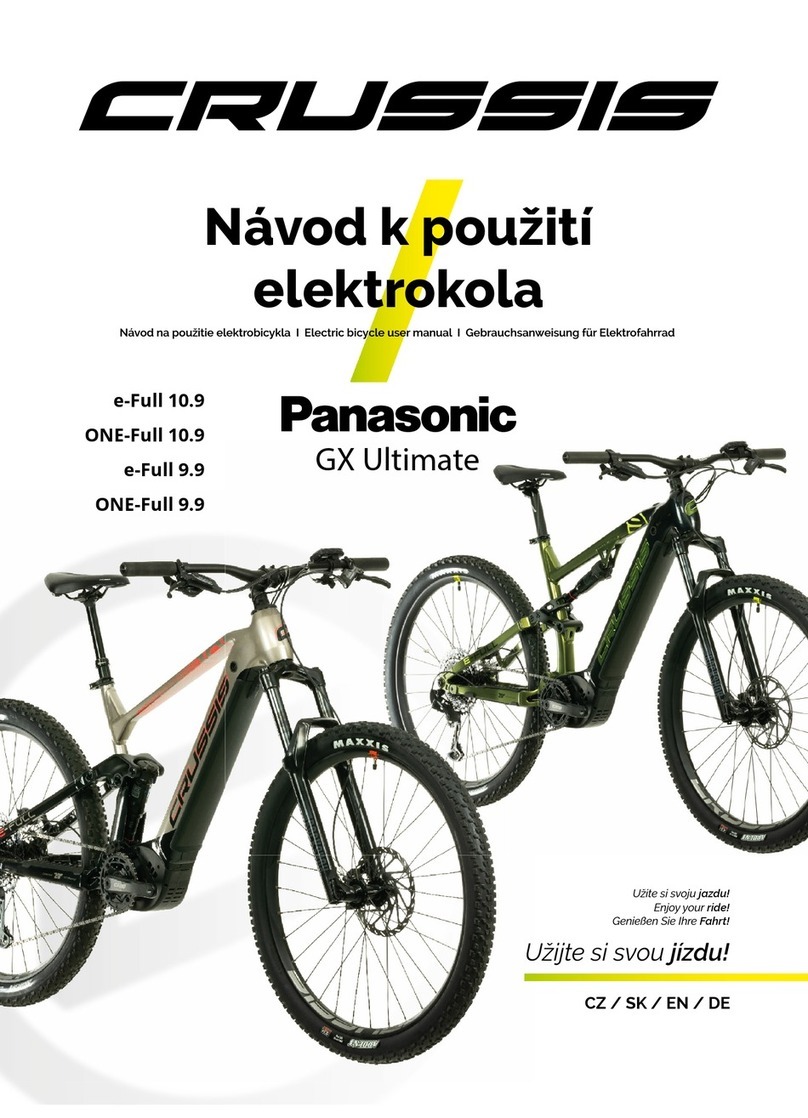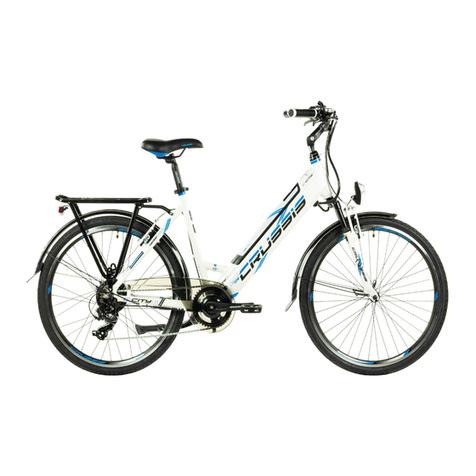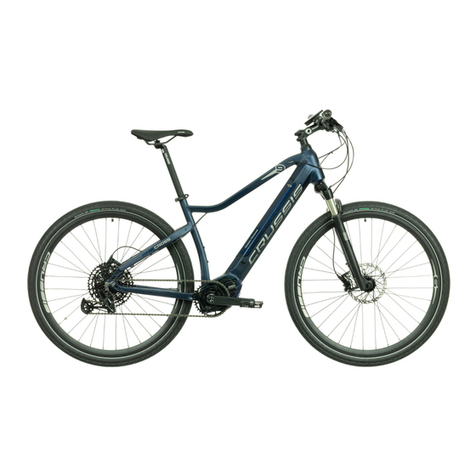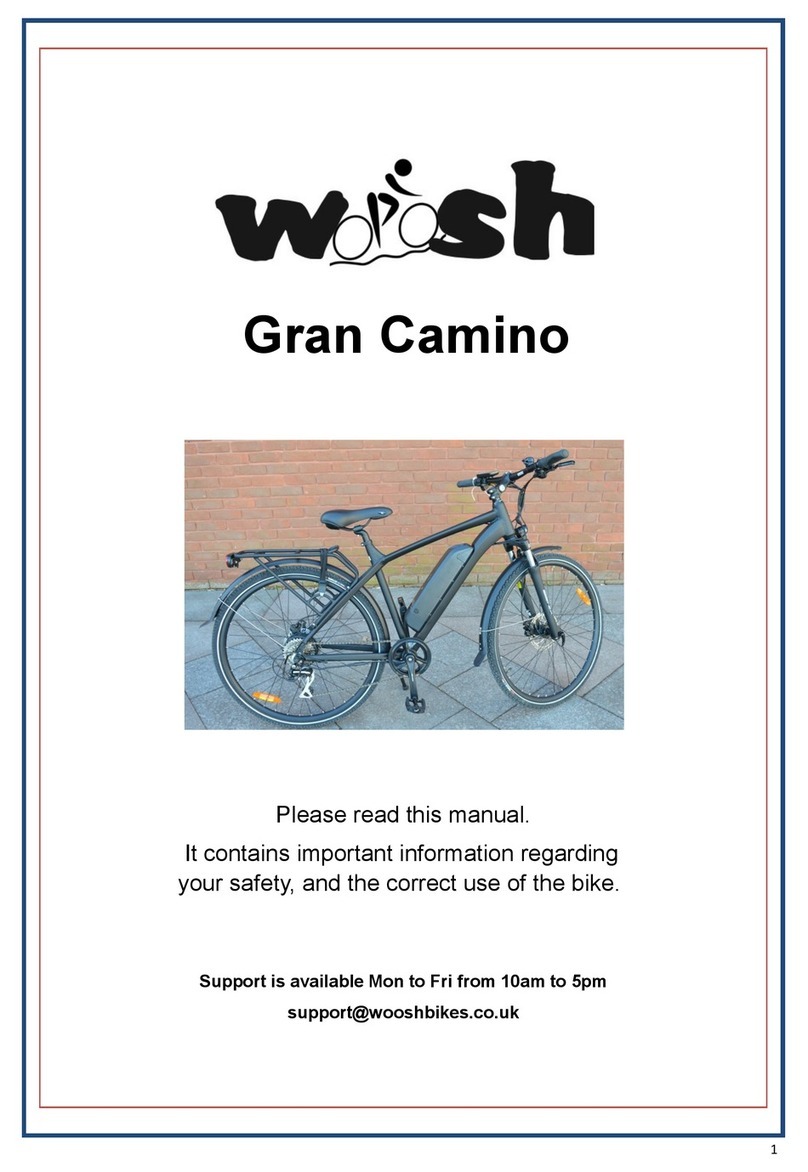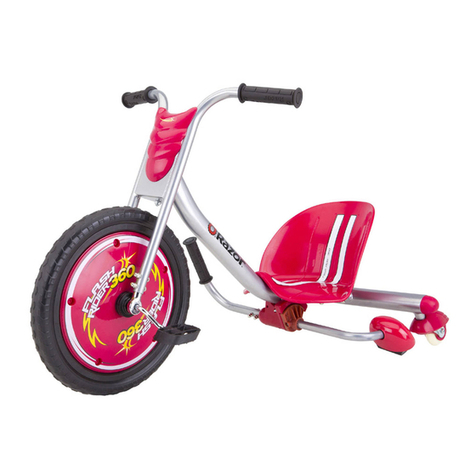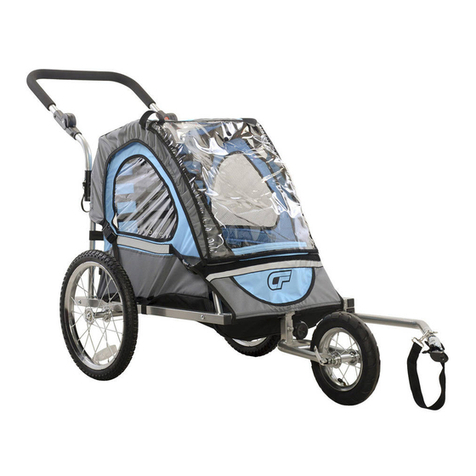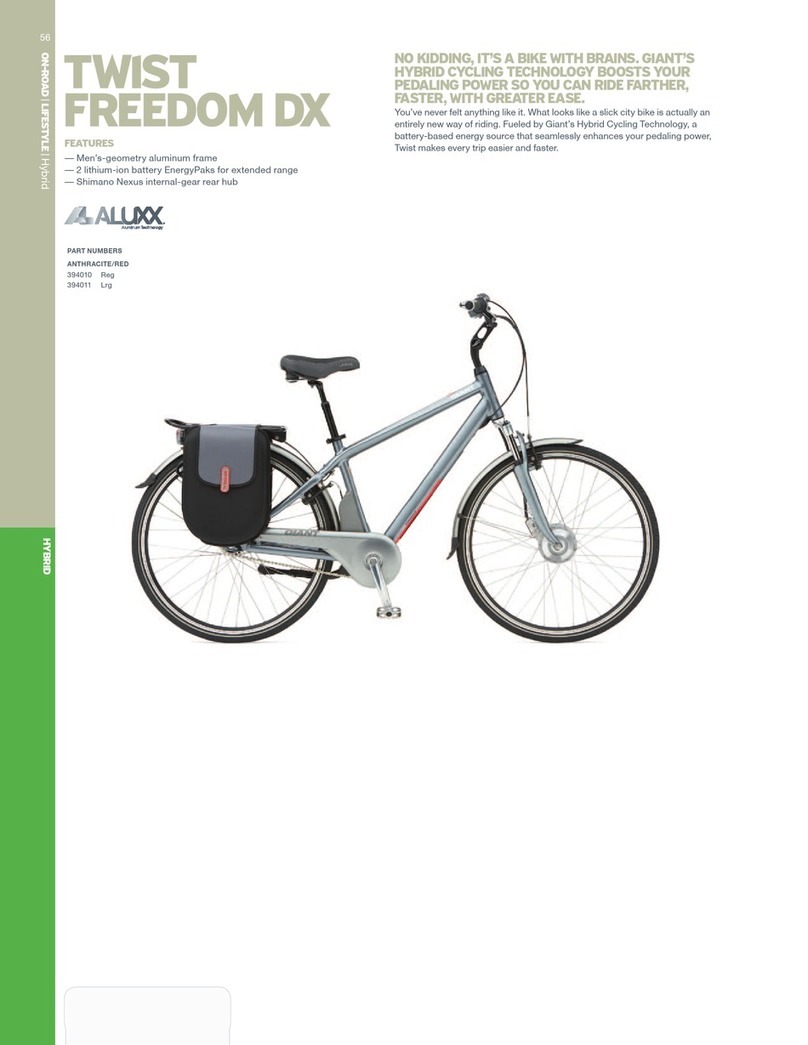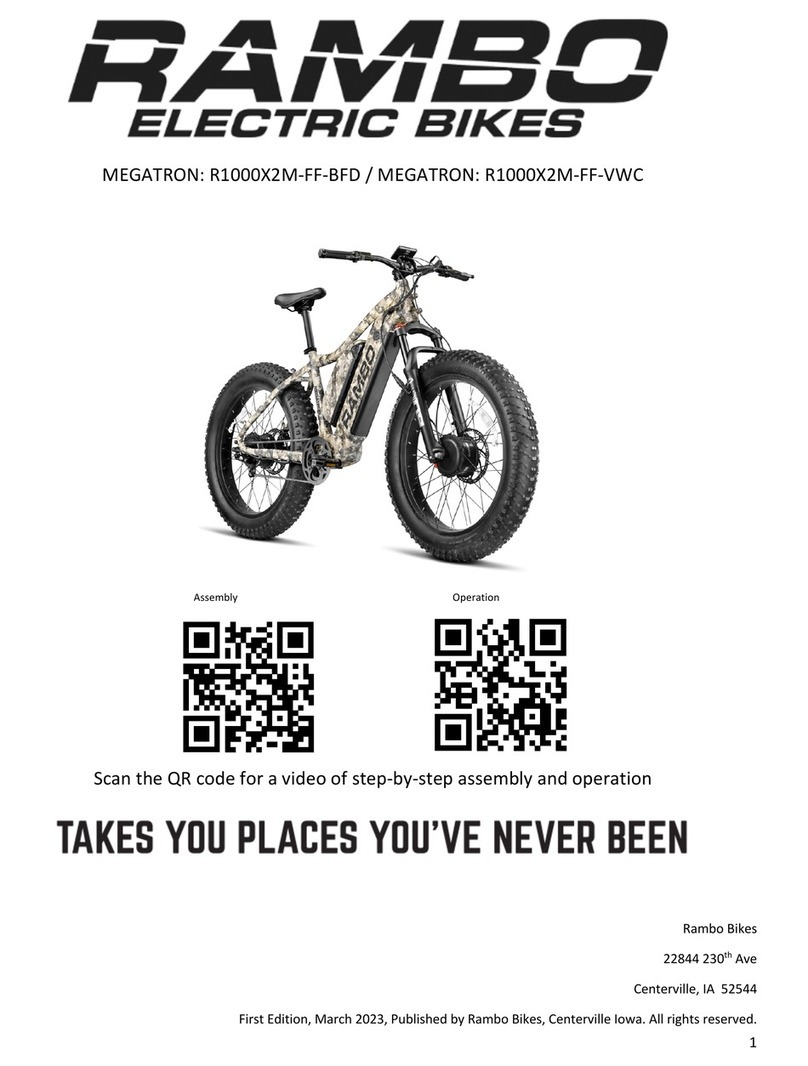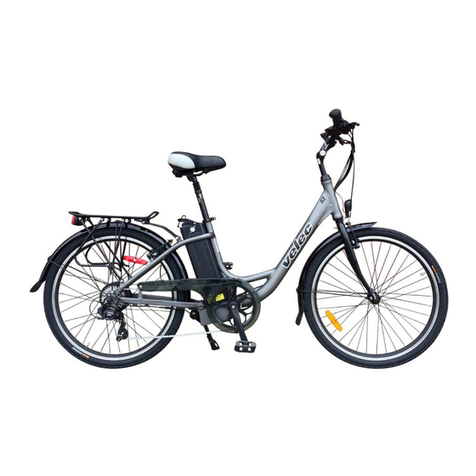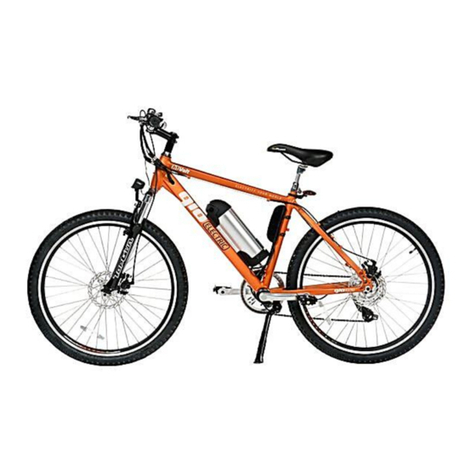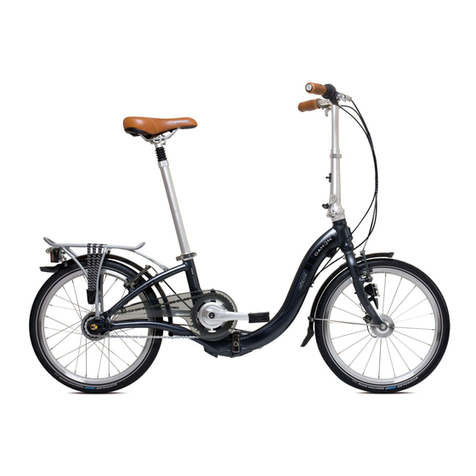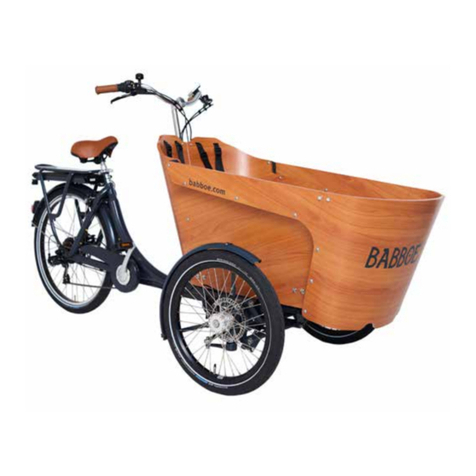CRUSSIS OLI Guera 8.7-S User manual

Electric bicycle
user manual
Enjoy your e-ride!
CZECH ELECTRIC BICYCLES MANUFACTURER
OLI Guera 8.7-S / 8.7-M
OLI Atland 8.7-S / 8.7-M
OLI Fionna 8.7-S / 8.7-M
OLI Largo 8.7-S / 8.7-M
OLI Cross 8.7-S / 8.7-M
OLI Cross lady 8.7-S / 8.7-M
ONE-OLI Guera 8.7-S / 8.7-M
ONE-OLI Largo 8.7-S / 8.7-M
ONE-OLI Cross 8.7-S / 8.7-M
ONE-OLI Cross lady 8.7-S / 8.7-M

Content
Foreword ..................................................................................................................................3-4
General warnings ....................................................................................................................5-9
E-bike system .......................................................................................................................10-13
Electric bike control (color LCD display) ...........................................................................13-18
Problem solving ........................................................................................................................19
Maintenance and storage ........................................................................................................20
Safety warning .....................................................................................................................20-21
Warranty ....................................................................................................................................21

3
Foreword
Dear users,
Thank you for purchasing a CRUSSIS e-bike! We appreciate you choosing our product.
For proper operation of the CRUSSIS e-bike, read the product information carefully be-
fore using it. In this manual we inform you about all the details related to the use of the
e-bike (including the installation of the device, settings and normal use of the display).
This manual will also help you solve any ambiguities and problems.
CRUSSIS ELECTROBIKES s.r.o wishes you many beautiful and safe kilometers on the
new e-bike.
Seznam prodejců CRUSSIS naleznete na webových stránkách www.crussis.cz.
What is e-bike?
It is a classic bicycle that is equipped with an electric motor. It can be located in the center, rear or
front hub. The electric motor can have a power not exceeding 250 W. The maximum assistance
speed is limited to 25 km/h and this restriction corresponds to the European standard EN 15194-1
(if this speed is exceeded, the electric motor switches o and on as soon as the speed falls below
this limit). Furthermore, the bike is equipped with a battery, which can be placed in the frame or on
the rear carrier. The most important parameter of the battery is voltage and capacity. The higher the
value, the greater is the range of the e-bike. Currently, the most commonly used batteries are lithi-
um ion (Li-ion). The advantage of these batteries is mainly in low weight and long life. It is important
to keep the battery charged regularly to extend its lifetime. Communication between the individual
electrical components is provided by the control unit, which evaluates the data from the individual
sensors, according to which it controls the power of the electric motor. The electric motor is opera-
ted by the control panel, on which you will nd information about the battery status, support level
and remaining range. For most displays, time, speed and distance traveled are a matter of course.
The motor function is activated by pedaling, which is detected by a special sensor located in the
pedal center. So you still have to pedal on the e-bike, the motor only helps you. The pedal sensor
is responsible for informing the control unit whether the rider has started or stopped pedaling and
informs about the pedaling frequency. This function is provided by either a magnetic pass sensor or
a torque sensor. The magnetic pass sensor is a basic sensor that works on the magnetic principle.
This sensor, which is installed on the center axis, controls the pedaling frequency. Activation of the
sensor by pedaling back is impossible due to the phasing of the magnets. Torque sensors are used
on more expensive sports e-bikes. Unlike magnetic sensors, they provide information about both
the pedaling frequency and the force apllied on the pedal. The torque sensor is ideal for o-road
driving, where there are frequent changes in the pedaling frequency. If we need to pedal with more
force, the motor will immediately help us with more power. On the contrary, when driving downhill,
when there is less pressure on the pedal, the motor function is limited, thus saving battery power.

4
You can set the e-bike in to motion using the control button , which is located on the display con-
troller, but only up to the maximum allowed speed, 6km/h (used for walking assistance). The electric
bicycle, which complies with the European standard EN 15194-1, is considered to be an ordinary
bicycle from the point of view of the Road Trac Act. This means that you can ride cycle paths, you
do not need a driver‘s license and the helmet is only mandatory until the age of 18. We recommend
using a bicycle helmet for all users, regardless of age.
Elektrokolo komponenty
1
2
3
4
5
6
7
8
9
10
11
12
1
2
3
4
5
6
7
8
9
10
11
12
8. shifter lever
6. battery lock
1. battery
12. tire and rim
5. brake levers
3. control panel
11. derailleur
4. torque sensor inside the motor
2. motor
9. cranks and pedals
10. wheel quick release
7. brakes
battery
motor
control panel (lcd display)
torque sensor inside the motor
brake levers
battery lock
brakes
shifter lever
cranks and pedals
wheel quick release
derailleur
tire and rim

5
3. control panel
GENERAL WARNINGS
Riding an e-bike, like other sports, can carry risk of injuries and damage. If you want to use an e-bi-
ke, you must become familiar with the rules of safe e-bike riding, proper use and maintenance of
the e-bike and follow them. Regular maintenance and proper use will reduce the risk of injury and
extend the lifetime of the product.
The OLI Atland, OLI Fionna, OLI Guera, ONE-OLI Guera, OLI Largo, ONE-OLI Largo e-bike mo-
dels are suitable for riding on paved roads, cycle paths, gravel and forest roads, and o-road
riding. E-bikes are equipped by tires with a coarser pattern to ensure sucient grip for o-
-road riding. Therefore, vibrations may occur when driving on a smooth surface (asphalt, con-
crete ...).
The OLI Cross , ONE-OLI Cross, OLI Cross lady, ONE-OLI Cross lady e-bike models are suitable
for riding on paved roads, cycle paths, gravel and forest roads.
Electric bikes are not suitable for wading, for any jumping and strikes from heights, do notElectric bikes are not suitable for wading, for any jumping and strikes from heights, do not
use them for extreme riding in dicult terrain (downhill, enduro, obstacle rides)!use them for extreme riding in dicult terrain (downhill, enduro, obstacle rides)!
When assembling the e-bike from the box, it is necessary to remove the battery from the fra-When assembling the e-bike from the box, it is necessary to remove the battery from the fra-
me before connecting the EB-BUS connector to the display. We recommend assembling andme before connecting the EB-BUS connector to the display. We recommend assembling and
adjusting the e-bike in a professional e-bike service.adjusting the e-bike in a professional e-bike service.
The e-bike can be used as a classic bicycle without the assistance of an electric motor. During non-
-assisted driving (ie assist 0), each e-bike puts on some resistance caused by the transmission in the
motor.
Before you ride for the rst time, check:
• Correct e-bike size: Improperly selected wheel size can aect e-bike maneuverability.
• Saddle setting: The correct height and position of the saddle aects the comfortable ride and con-
trol of the bike.
Saddle adjustment: Correct saddle height and position aect comfortable riding and driving control.
The position of the saddle on the seat post is determined by the scale on the saddle rails, there is a
mark for maximum backward and forward movement to the handlebars!
Note: groove on the seat post indicates the maximum allowed pulled out position. Never adjust
the seat post above this groove! This will prevent damage of the e-bike frame or saddle tubes and
possible injury.
• The correct height of the stem and handlebars.
Regular inspection:
Check the condition of your e-bike regularly before each ride. In this way, many technical problems
can be avoided intime. The consequences of irregular inspections can be catastrophic in many ca-
ses. The lifetime of the frame or components is aected by the construction and material used, as
well as the maintenance and intensity of use. Regular inspections of qualied professionals should
be a matter of course. Lift up the e-bike to a height of 5 - 10 cm above the ground and release. By this
you will make sure that everything is tightened suciently. Then perform a visual and touch inspec-
tion of the entire e-bike, especially the correct tightening of all bolts, nuts, pedal center, pedals, etc.
This manual suits for next models
19
Table of contents
Other CRUSSIS Bicycle manuals
